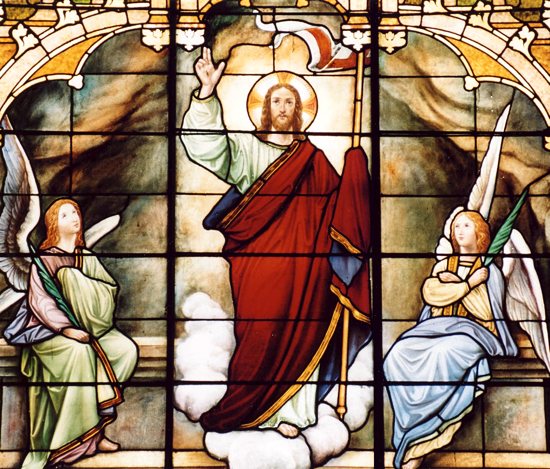 A Miraculous Encounter. On Easter Sunday morning when Mary Magdalene, Joanna, Mary the mother of James, and a number of other women from Galilee went to the tomb of Jesus, they encountered “two men in dazzling garments” (Lk 24:4).
A Miraculous Encounter. On Easter Sunday morning when Mary Magdalene, Joanna, Mary the mother of James, and a number of other women from Galilee went to the tomb of Jesus, they encountered “two men in dazzling garments” (Lk 24:4).
A Curious Discrepancy. Each of the four evangelists mentions the presence of one or two mysterious figures at the tomb. Matthew explained that “an angel of the Lord descended from heaven, approached, rolled back the stone, and sat upon it. His appearance was like lightning and his clothing was white as snow” (Mt 28:2,3). Mark reported that the women, upon entering the tomb, “saw a young man sitting on the right side, clothed in a white robe” (Mk 16:5). In the Fourth Gospel John the evangelist recounted how Mary Magdalene “saw two angels in white sitting there, one at the head and one at the feet where the body of Jesus had been” (Jn 20:12). In Matthew and Mark there is one figure, while in Luke and John there are two. Who are they? Why is the number different?
Unique Identity. There are multiple details that reveal the identity of the figures present in the tomb. Both Matthew and John state explicitly that they were angels. All four gospels say that the figures were clothed in white or dazzling garments, a sign they came from heaven, the abode of the angels. Each delivered an announcement from God that Jesus was risen from the dead, and it is the duty of angels to serve as divine messengers.
One or Two Angels. Modern rationalistic philosophy and the scientific method strive for factual accuracy and precision, while the evangelists use details to convey a symbolic message. There are several plausible reasons why Luke prefers two angels to one. Luke uses pairs throughout his gospel: Zechariah and Elizabeth, Simeon and Anna, the cure of a leper and the cure of a paralytic, Martha and Mary, and many others. When it comes to the angels, it is preferable for them to work together in tandem rather than by themselves, alone. Furthermore, when it comes to the strength of testimony, in the Mosaic Law a statement given by an individual is considered insufficient or unreliable, while the word of two gives necessary corroboration and verification (see Dt 19:15).
The Two-Figure Symbolism. There is a strong likelihood that Luke wants the reader to make a connection between the Transfiguration and the Resurrection. When Jesus was transfigured, two men in glory appeared with him (Lk 9:30,31), and when Jesus was raised two men in dazzling garments appeared (Lk 24:4). Moses and Elijah came from heaven and the two figures in the tomb also came from heaven. Moses and Elijah spoke of Jesus’ exodus that he was going to accomplish in Jerusalem (Lk 9:31), and men in dazzling garments spoke about the completion of Jesus’ exodus on earth in anticipation of his future and final exodus, his Ascension to heaven.




